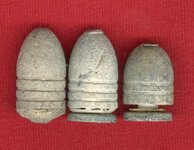Carolina Tom
Gold Member
I dug this in the Lowcountry of SC, on a historic property with a lot of Civil War activity.
Any assistance with the ID is appreciated. I believe it is a fired Williams cleaner with the disc still in it. I don’t recall seeing anything like this before. I thought the disc burned up when the bullet went down the barrel.
It weighs 27.4 grams. The disc is .54” in diameter.
It looks like it has/had rings on it.


Looks like it impacted something head on.


Thanks for looking.
Any assistance with the ID is appreciated. I believe it is a fired Williams cleaner with the disc still in it. I don’t recall seeing anything like this before. I thought the disc burned up when the bullet went down the barrel.
It weighs 27.4 grams. The disc is .54” in diameter.
It looks like it has/had rings on it.


Looks like it impacted something head on.


Thanks for looking.







